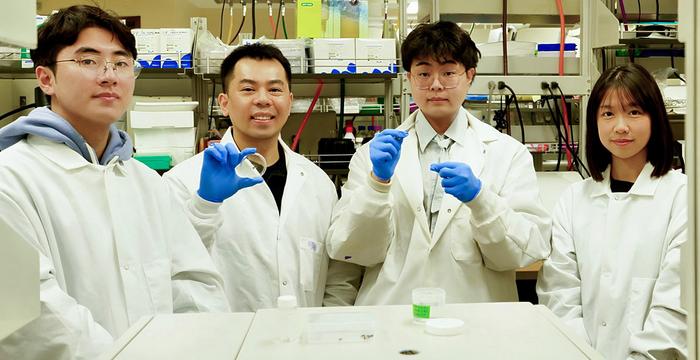Researchers at Binghamton University are pioneering a groundbreaking approach to addressing spinal cord injuries by developing an innovative hydrogel electrode. This initiative is led by Assistant Professor Siyuan Rao and her research team within the Neurobiological Interfaces Lab. Their work aims to solve the persistent challenge of finding suitable materials that can transmit clear signals from the nervous system while maintaining flexibility, especially during patient movement. This balance is paramount in mitigating damage that can arise from using rigid materials in soft tissues.
The core of this research lies in the creation of hydrogel electrodes that are embedded with conductive carbon nanotubes. This unique composition grants the hydrogels electrical conductivity, which is essential for effectively monitoring nerve activity. In their latest findings, published in the prestigious journal Nature Communications, the team reported the successful integration of these hydrogel electrodes into bioelectronic devices. This integration enables accurate recording of electrical signals emitted by spinal cord neurons and leg muscles in mice, thus offering valuable insights into neural function and potential interventions for spinal injuries.
Professor Rao emphasizes the risks associated with using inflexible materials in contexts sensitive to motion. “If you have a rigid material in a soft tissue, especially during movement, it’s going to cause significant damage,” she asserts, highlighting the importance of biocompatibility in their designs. The hydrogel technology developed by her team addresses these concerns, allowing for prolonged functionality without compromising the delicate tissue structures within the spinal system. This innovation not only underscores a shift in material science but also opens up new avenues for research into spinal cord repair and degeneration.
The collaborative nature of this research project includes contributions from several prominent figures in the field. Among them is lecturer Sizhe Huang, who has taken a leadership role within the lab. Huang’s perspective on teamwork mirrors a well-coordinated effort; likening his experience to driving a car where he responsibly navigates while mentoring master’s students, he emphasizes the importance of collective contribution and shared knowledge in scientific research settings.
In addition to Rao and Huang, the study features a diverse set of researchers including PhD students and technicians from Binghamton University, as well as collaborators from esteemed institutions such as the University of Massachusetts, University of Texas, Michigan State University, MIT, and Boston Children’s Hospital. This expansive network not only enhances the study’s credibility but also facilitates a rich exchange of ideas and methodologies, significantly bolstering their research initiatives.
A noteworthy feature of the hydrogels being developed is their composition from a synthetic plastic polymer that is both non-toxic and biocompatible. This ensures that the materials not only perform effectively in signaling but also do not evoke adverse biological responses. With their high absorption capacity, these hydrogels can encapsulate conductive materials like carbon nanotubes, which are crucial for signal transmission. The inclusion of such nanomaterials elevates the hydrogel electrodes from traditional applications, enhancing their functionality in complex biological environments.
Rao and her team are particularly excited about leveraging their hydrogels for investigations into pain inhibition and motor function recovery within the spinal cord. She indicated their next steps include examining the ventral horn motor neurons responsible for voluntary movement. By using light-based techniques to address pain inhibition, they aim to synergize these approaches with their conductive hydrogel materials, owing to its potential to record electrophysiological signals effectively.
Building on prior research that focused on brain interfaces, this team’s efforts signify a direct application to the spinal cord, a region that has historically posed challenges for effective intervention strategies. The ability to selectively target discrete neural populations represents a significant advancement in understanding the central nervous system’s complex interrelations, further bridging gaps in neuroprosthetics and rehabilitation practices.
In addition to advancing scientific understanding, findings from this study hold significant implications for clinical applications. The potential to create tools that interface effectively with the nervous system could radically transform treatment approaches for spinal cord injuries, degenerative diseases, and other neurophysiological conditions. Each step taken by the researchers points toward a promising future where advanced materials can ameliorate the lives of individuals affected by debilitating spinal conditions.
The call for further research is clear, as the interplay between advanced material sciences and biomedical engineering continues to offer unprecedented opportunities. The team is committed to further developing their hydrogel technology, fine-tuning its properties for enhanced sensitivity and specificity in recording neural signals. As they strive for a deeper understanding of spinal cord dynamics, the expectations for future breakthroughs only continue to mount.
In conclusion, the work being conducted by the Binghamton University team stands at the intersection of engineering, biology, and medicine, showcasing how interdisciplinary approaches can forge paths toward innovative solutions. Through their unwavering commitment to enhancing the capabilities of neural interfacing technologies, they are not only contributing to scientific literature but are also setting a foundation for transformative therapies in the neuroscience field.
With every leap in technology, researchers like Rao and Huang are proof that understanding and interacting with the nervous system’s complexities can pave the way for new, more effective treatments for spinal cord injuries and other related ailments.
Subject of Research: Animal tissue samples
Article Title: Anisotropic hydrogel microelectrodes for intraspinal neural recordings in vivo
News Publication Date: 28-Jan-2025
Web References: Nature Communications
References: Research data is drawn from internal publications and collaborative studies listed above.
Image Credits: Credit: Siyuan Rao
Keywords
Spinal cord injuries, Basic research, Electrical conductivity, Hydrogels, Spinal cord, Doctoral students, Undergraduate students, Academic researchers, Universities, Neural inhibition, Pain, Academic publishing, Electrodes, Carbon nanotube applications, Motor neurons, Peripheral nervous system, Brain structure.
Tags: assistant professor Siyuan Raobioelectronic devices for spinal injuriesconductive carbon nanotubes researchelectrical conductivity in hydrogelsflexible materials for nerve signalshydrogel electrode innovationmonitoring nerve activity in miceNature Communications publicationneurobiological interfaces labrisks of rigid materials in soft tissuesspinal cord injury treatmentspinal cord neuron recording





